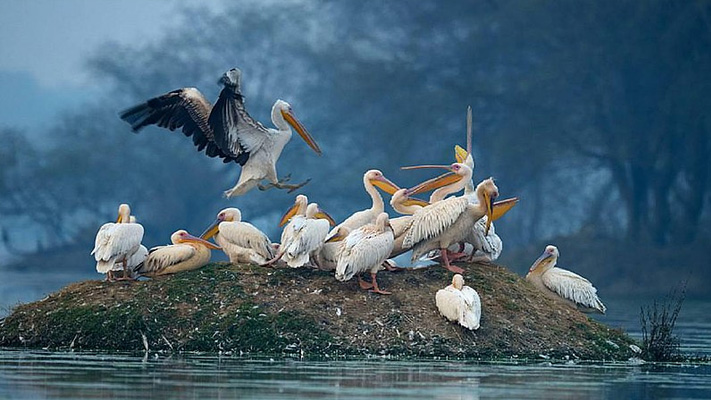NATIONAL PARKS NEAR DELHI FOR A WEEKEND TRIP – ESCAPE THE CROWDS AND ENJOY THE WILD

Escape the bustling city of Delhi and embark on a refreshing weekend getaway to the national parks near the capital. Just a short distance away, these natural havens offer a respite from the urban chaos and a chance to immerse yourself in the beauty of the wilderness. From spotting majestic tigers in Jim Corbett National Park to witnessing the vibrant avian life in Keoladeo National Park, these national parks near Delhi are perfect for a short but fulfilling adventure. With opportunities for wildlife safaris, nature walks, and birdwatching, these sanctuaries provide an excellent opportunity to reconnect with nature and create unforgettable memories. Get ready to explore the wilderness and witness the wonders of the natural world on a weekend trip to the national parks near Delhi.

1. Jim Corbett National Park
Jim Corbett National Park, located in Uttarakhand, is one of the most renowned national parks in India. Here’s some information about Jim Corbett National Park, including its distance from Delhi, visitor experiences, and activities:
Distance from Delhi: Jim Corbett National Park is approximately 240 kilometers away from Delhi, which can be covered by a road journey of around 5-6 hours.
Visitor Experiences and Activities:
1. Wildlife Safaris: The main attraction of Jim Corbett National Park is the opportunity to go on thrilling wildlife safaris. Jeep safaris and elephant safaris are available, allowing visitors to explore the park’s diverse ecosystems and spot a wide variety of wildlife, including tigers, elephants, leopards, deer, and numerous bird species.
2. Birdwatching: Jim Corbett National Park is a paradise for birdwatching enthusiasts. The park is home to over 600 bird species, making it a haven for avian diversity. Visitors can embark on birdwatching tours to observe and photograph these beautiful creatures in their natural habitats.
3. Nature Walks and Trekking: Enjoy the serene surroundings of Jim Corbett National Park by taking nature walks or going on guided treks. Trained naturalists will lead you through the park’s trails, providing insights into the flora, fauna, and ecosystems of the region.
4. Wildlife Photography: With its stunning landscapes and diverse wildlife, Jim Corbett National Park offers ample opportunities for wildlife photography. Capture memorable shots of the animals, birds, and scenic vistas that make this park a photographer’s delight.
5. River Rafting: The Kosi River flows through Jim Corbett National Park, offering thrilling river rafting experiences for adventure enthusiasts. Enjoy the adrenaline rush as you navigate the rapids and soak in the natural beauty of the surroundings.
6. Visit Corbett Museum: Located at Kaladhungi, the Corbett Museum is dedicated to the life and achievements of Jim Corbett, a famous naturalist, hunter, and conservationist after whom the park is named. Explore the museum to learn about his fascinating life and contributions to wildlife conservation.
7. Dhikala Canter Safari: The Dhikala Zone is a popular area within the national park, known for its dense forests and abundant wildlife. The Dhikala Canter Safari allows visitors to explore this zone on a shared vehicle, offering an opportunity to spot wildlife and enjoy the picturesque landscapes.
2. Ranthambore National Park
Ranthambore National Park, situated in Rajasthan, is a renowned wildlife sanctuary known for its population of royal Bengal tigers. Here’s some information about Ranthambore National Park, including its distance from Delhi, visitor experiences, and activities:
Distance from Delhi: Ranthambore National Park is approximately 380 kilometers away from Delhi, and it takes around 7-8 hours to reach by road.
Visitor Experiences and Activities:
1. Tiger Safaris: The main attraction of Ranthambore National Park is the opportunity to spot majestic tigers in their natural habitat. Visitors can embark on thrilling tiger safaris in open-top jeeps or canters accompanied by experienced naturalists and guides. The park is divided into different zones, and each zone offers a unique wildlife viewing experience.
2. Wildlife Spotting: Apart from tigers, Ranthambore is home to a diverse range of wildlife, including leopards, sloth bears, sambar deer, spotted deer, Indian gazelles, and various bird species. Enjoy the excitement of spotting these animals and capturing their beauty through wildlife photography.
3. Bird-watching: Ranthambore National Park is a paradise for bird lovers. The park boasts over 300 bird species, including the Indian grey hornbill, painted stork, crested serpent eagle, and the critically endangered Indian vulture. Embark on bird-watching trails or safaris to observe and photograph these feathered creatures.
4. Fort and Temple Visit: Within the park, you can explore the historic Ranthambore Fort, a UNESCO World Heritage site. The fort offers panoramic views of the surrounding landscape and is home to ancient temples, including the famous Ganesh Temple.
5. Village and Cultural Tours: Experience the local culture and lifestyle by taking a village tour around Ranthambore. Interact with the villagers, witness traditional handicrafts, and gain insights into the region’s rural life.
6. Nature Walks: Immerse yourself in the serene surroundings of Ranthambore by taking guided nature walks. These walks offer an opportunity to appreciate the park’s flora, fauna, and the intricate ecosystem that supports its wildlife.

3. Sariska Tiger Reserve
Sariska Tiger Reserve, located in the Alwar district of Rajasthan, is a prominent national park and wildlife sanctuary. Here’s some information about Sariska Tiger Reserve, including its visitor experiences and activities:
- Distance from Delhi: Sariska Tiger Reserve is approximately 200 kilometers away from Delhi, and it takes around 4-5 hours to reach by road.
- Tiger Safaris: Sariska Tiger Reserve is known for its tiger population, offering visitors a chance to spot these majestic creatures in their natural habitat. Jeep safaris, accompanied by trained guides, take you through the park’s varied terrain, increasing the chances of tiger sightings.
- Wildlife Spotting: Along with tigers, Sariska is home to a variety of wildlife, including leopards, striped hyenas, wild boars, sambar deer, and nilgai. Enjoy the thrill of spotting these animals and capturing their beauty through wildlife photography.
- Bird-watching: Sariska Tiger Reserve is a paradise for bird enthusiasts, with over 200 bird species recorded. Bird-watching trails and observation points allow visitors to observe and photograph resident and migratory birds, such as peafowl, grey partridge, Indian eagle-owl, and the endangered white-backed vulture.
- Nature Walks: Explore the natural beauty of Sariska Tiger Reserve on guided nature walks. Trained naturalists will accompany you, providing insights into the park’s flora, fauna, and the delicate ecosystem it supports.
- Sariska Palace: The Sariska Palace, located within the reserve, is a grand heritage hotel that was once a hunting lodge for the royal family. Visitors can experience a taste of history and luxury by staying at or visiting the palace.
- Kankwari Fort: The Kankwari Fort, situated within the reserve, is a historic attraction that dates back to the 17th century. It offers panoramic views of the surrounding landscape and provides insights into the region’s historical significance.
- Haunted Bhangarh Fort: Located near Sariska Tiger Reserve, the Bhangarh Fort is infamous for its haunted reputation. Although not officially part of the reserve, it is a popular side trip for those interested in supernatural tales and historical sites.
4. Keoladeo National Park
Keoladeo National Park, formerly known as Bharatpur Bird Sanctuary, is a UNESCO World Heritage site located in the state of Rajasthan. Here’s some information about Keoladeo National Park, including its distance from Delhi, visitor experiences, and activities:
- Distance from Delhi: Keoladeo National Park is approximately 190 kilometers away from Delhi, and it takes around 4-5 hours to reach by road.
- Bird-watching: Keoladeo National Park is a haven for birdwatching enthusiasts. It is home to over 370 bird species, including both resident and migratory birds. Visitors can spot species like the Siberian crane, painted stork, Indian sarus crane, spoonbill, and various species of herons, kingfishers, and eagles.
- Guided Tours: The park offers guided tours conducted by knowledgeable naturalists who provide insights into the park’s avian diversity, habitats, and conservation efforts. They can help identify different bird species and share interesting facts about their behavior and migration patterns.
- Cycle Rickshaw Rides: One of the popular ways to explore Keoladeo National Park is by taking a cycle rickshaw ride. These guided rides allow visitors to leisurely traverse the park’s trails, stopping at various birding hotspots and soaking in the natural beauty.
- Nature Walks: Keoladeo National Park has well-laid-out walking trails that allow visitors to explore the park at their own pace. Stroll along the pathways, observe birds in their natural habitats, and enjoy the serene surroundings.
- Boating: During the monsoon season when the park is flooded, boating is available for visitors. It provides a unique perspective to observe water birds and their nesting sites.
- Interpretation Centre: Visit the Interpretation Centre within the park to learn about the diverse flora, fauna, and conservation efforts of Keoladeo National Park. Exhibits, displays, and audio-visual presentations offer insights into the park’s ecology and the importance of bird conservation.

5. Sultanpur National Park
Sultanpur National Park, located in Haryana, is a popular bird sanctuary near Delhi. Here’s some information about Sultanpur National Park, including its distance from Delhi, visitor experiences, and activities:
- Distance from Delhi: Sultanpur National Park is approximately 46 kilometers away from Delhi, and it takes around 1-2 hours to reach by road.
- Bird-watching: Sultanpur National Park is renowned for its avian diversity, making it a paradise for birdwatching enthusiasts. The park is home to over 250 bird species, including migratory birds from Central Asia and Siberia. Visitors can spot birds like the Siberian crane, white-throated kingfisher, painted stork, spot-billed pelican, and many more.
- Nature Walks: Sultanpur National Park offers well-marked trails and pathways for visitors to explore the park on foot. Take a leisurely nature walk, observe the diverse birdlife, and enjoy the peaceful surroundings. Keep an eye out for other wildlife species like deer and monkeys.
- Photography: Capture the vibrant plumage and captivating moments of the bird species found in Sultanpur National Park. The park provides excellent opportunities for bird and nature photography, allowing visitors to preserve their memories and document the rich avian biodiversity.
- Bird Hideouts: The park features strategically located bird hideouts or observatories that provide a closer view of the birds without disturbing their natural behavior. Spend time at these hideouts, patiently observing and photographing the birds in their natural habitats.
- Interpretation Centre: Visit the Interpretation Centre within the park to learn about the various bird species, their habitats, migration patterns, and conservation efforts. Exhibits and displays offer valuable information to enhance your understanding of the avian world.
- Picnicking: Sultanpur National Park offers designated picnic spots where visitors can relax, enjoy a meal, and soak in the tranquility of the surroundings. It’s a perfect opportunity to spend quality time with family and friends amidst nature.
- Nature Education: The park conducts various educational programs and activities to raise awareness about birds, wildlife conservation, and the importance of preserving natural habitats. Check with the park authorities for any ongoing workshops or talks during your visit.

















































